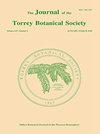The introduction of Japanese knotweed, Reynoutria japonica, into North America1
IF 0.8
4区 生物学
Q4 PLANT SCIENCES
引用次数: 5
Abstract
This article presents the discovery of earliest known references to the cultivation of Japanese knotweed, Reynoutria japonica, in North America. As described in articles from 1868, 1872, and 1875 there were three distinct introductions of the plant in the 1860s, two from Europe and one from Japan. The European introductions consisted of the now widespread, seedless female clone introduced into commerce by Philipp von Siebold in the 1840s and a dwarf, seed-producing variety with reddish stems, probably also introduced by von Siebold. The introduction from Japan was sent by Thomas Hogg to his brother James’s nursery in New York City and produced ‘‘an abundance of rose-colored fruits.’’ Serendipitously, an herbarium specimen collected from Hogg’s plant in 1873 was discovered in in 2006 and its examination strongly suggests that the introduction consisted of at least one male and one female plant. Thomas Hogg’s independent introduction of the species from Japan could well explain the higher levels of genetic diversity displayed by Japanese knotweed populations in eastern North America compared to those in Europe.日本虎杖(Reynoutria japonica)在北美的引种
这篇文章介绍了在北美发现的最早的关于日本结叶草的栽培资料。正如1868年、1872年和1875年的文章所描述的那样,这种植物在19世纪60年代有三次不同的引进,两次来自欧洲,一次来自日本。欧洲的引进品种包括现在广泛传播的无籽雌性克隆品种,由菲利普·冯·西博尔德在19世纪40年代引入商业,还有一种矮矮的、有红色茎的种子品种,可能也是由冯·西博尔德引入的。托马斯·霍格(Thomas Hogg)从日本引进这种植物,送到他哥哥詹姆斯(James)在纽约的苗圃,结出了“大量玫瑰色的果实”。“偶然的是,在2006年发现了1873年从霍格的植物中收集的植物标本,其检查强烈表明,引入的植物至少包括一株雄性和一株雌性植物。托马斯·霍格(Thomas Hogg)从日本独立引进该物种,这可以很好地解释为什么北美东部的日本结须种群比欧洲的结须种群表现出更高的遗传多样性。
本文章由计算机程序翻译,如有差异,请以英文原文为准。
求助全文
约1分钟内获得全文
求助全文
来源期刊
CiteScore
0.70
自引率
0.00%
发文量
16
审稿时长
>12 weeks
期刊介绍:
The Journal of the Torrey Botanical Society (until 1997 the Bulletin of the Torrey Botanical Club), the oldest botanical journal in the Americas, has as its primary goal the dissemination of scientific knowledge about plants (including thallopyhtes and fungi). It publishes basic research in all areas of plant biology, except horticulture, with an emphasis on research done in, and about plants of, the Western Hemisphere.

 求助内容:
求助内容: 应助结果提醒方式:
应助结果提醒方式:


